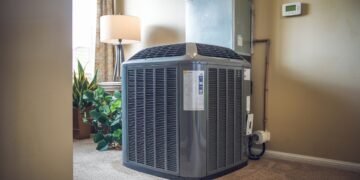Dishwashers are common appliances that are used on daily basis. The machine allows you to enjoy your evening without wasting time on washing dishes. Simply put all your plates in the washer and let the machine work for you. But sometimes, the Dishwasher does not spray water after turning it on.
You may be facing this problem too. But, a dishwasher not spraying water doesn’t always mean it is broken or needs to be repaired. Poor water supply, clogged spray arm, water velvet, etc can develop such issue in the Dishwasher.
Moreover, making mistakes while running can also cause this problem. The most common is an irregular arrangement of dishes, not cleaning washer units, and others. The Causes may differ, but our troubleshooting guide explains all possible reasons behind the Dishwasher not spraying water. Additionally, we will assist you to resolve this problem at home on your own.
Why is My Dishwasher Not Spraying Water?
A dishwasher connects to your home water supply line. After the machine turns on, it pulls water and adds detergent. An in-built spray arm shoots the liquid to your dishes placed inside.
After completing the wash cycle, the dishwasher indicates its completion. If you open the door and notice dirty dishes still available in the washer, there may be an error.
1. Dishwasher is Overloaded
An overloaded dishwasher means your device is blocked with dishes, cups, or plates. Reviewers say you have to put your dishes in good manners. If the housing is stacked with plates, your Dishwasher must be fixed.
Otherwise, you notice the machine is technically healthy, but the sprayer doesn’t work in its standard form. Remember, Dishwasher’s spray arm is located at the bottom of the housing. The arm shoots water vertically to your plates.
So if you stack the cups or plates upright above the arm, water will not reach them properly. That’s why it’s essential to place your dishes well and in a limited quantity in the machine.
2. Poor Water Supply
Your Dishwasher needs a water supply to spray and clean your dishes. Generally, the machine is connected to the home water line. By using the circulation pump, water is delivered to fill the bottom of the device. If the supply line is weak, the spraying issue is obvious.
However, there is an easy solution available for the occasion. Turn on your Dishwasher and start the wash cycle. Put your ear near the machine and ensure that there is a sound of water filling.
If your washer has a solid sound insulation facility, try to open the door mid-wash and ensure the step. That’s how you can determine if the problem is poor water supply or not.
3. Damaged Circulation Pump
The circulation pump plays a vital role in keeping the spray arm working. Indeed, this motor sucks the water and pumps it to the lower arm of the sprayer. That’s how the dishwasher sprayer shoots the water to the dishes.
It means damage or error in this motor can restrict the water flow and cause Dishwasher not to spray water. You should contact a technician to resolve the pump issue. This circulation pump also connects filters to absorb dust particles from the water.
If this filter gets clogged or blocked, sufficient water doesn’t deliver to the sprayer. To ensure the health of the motor and filter individually.
4. Error in Float Switch
The float switch is located at the bottom of your Dishwasher. This unit works as a sensor to detect the water level in the machine. After starting the wash cycle, water starts filling the housing. The float switch begins at a certain water level and indicates the washer to stop. The process helps to rinse the dishes and prevent overfilling the machine.
Sometimes, this floating switch stops working or delivers the wrong data to the washer. As a result, the Dishwasher does not spray water, the machine starts overflowing, or the plates keep dirty after the wash cycle. To ensure the switch is working correctly on your device.
5. Blockage in Spray Arm
Your dishwasher sprayer added a small narrow nozzle on the top. It works to shoot high-pressure water into your dishes. Blockage or debris in this space can restrict the water flow.
As a result, you experience the Dishwasher not spraying water effectively. There are several reasons to block the spray nozzle. One of the common reasons is the hard water supply at your home.
Either the water is dense or filled with many dust particles. Over time, minerals and dust can build up the nozzle and prevent regular water flow. So remove the sprayer nozzle and clean it by hand.
6. Blockage in Chopper Blade
Chopper blades are also a vital unit in the Dishwasher. This assembly line works to chop food particles, and debris flows with the water. Any clog in this area can restrict motor performance. As a result, sufficient water doesn’t flow to the sprayer and stops working.
However, clog or damage in chopper blades are common with age. You have to clean the unit once a month or timely. So follow the steps to keep your dishwasher sprayer functional.
7. Clogged Inlet Valve
The water inlet valve helps to flow the water to your dishwater. The sprayer will start irregularly if the unit is old and builds up clogs or debris. It’s because a poor water supply comes to your machine.
Additionally, many homes supply dense water that quickly develops minerals and debris in dishwasher units. So it’s better to keep these components cleaned once a month.
Also Read: GE Dishwasher Not Starting Just Beeping? Things Need to Fix
How to Fix a Dishwasher That is Not Spraying Water?
We hope you got all the possible reasons why your Dishwasher is not spraying water effectively. Depending on the situation, fix the problem you are facing. Additionally, you don’t need any tools or plumbers’ help. So keep reading our troubleshooting steps below.
1. Keep Dishes Organized
Previously we mentioned a sprayer located at the bottom and shooting water vertically. So you have to organize the plates accordingly. Too much compact space can restrict water flow and unwashed dishes after the cycle. So it’s always better to remove some plates or cups from the housing.
The general rule is to place two loads of dishes for washing. Additionally, you should put your bowels and cups facing down. So the water can clean them properly. In short, leave some space so the sprayer can reach all your dishes.
2. Fix the Home Water Supply
A sufficient water supply is vital to run your dishwasher machine properly. But sometimes, a few minor problems can restrict the flow. To ensure the home water supply line is functional.
First, check if the supply line is turned off. It is a common mistake that mostly happens after plumbing work. You or the worker may forget to turn on the pipe.
The Second is low water pressure inside the supply line. This condition also occurs in some instances. If your home water line faces a similar issue, avoid using the dishwasher for a while.
Thirdly, the pipeline can damage or leak for specific reasons. In this case, water will start flowing slowly, and the dishwasher faces a low volume of water flow.
So fix the water supply issue and resolve the sprayer problem in your dishwasher.
3. Clean Circulation Pump
The next step is to check a circulation pump that delivers water to the dishwasher sprayer. This unit is located at thebottom of the machine, just below the lower arm. So you should remove the bottom disk, lower arm, and mounted housing.
That’s how you get clear access to the circulation pump. Inspect the unit for debris, hair, dust, or food particles.
Clean the component by hand and place it again. If the sprayer still doesn’t work correctly, the pump may need replacement.
4. Replace the Float Switch
To inspect the float switch, you have two possible ways. First, you should remove the bottom panel for access. Now manually check the unit for any damage or crack. If you find any error, replace the float switch.
The second step is to ensure the attached microchip is working correctly. This unit is placed near the float switch, which helps communicate with the machine. Use a multimeter to ensure the sensor is working correctly. If it doesn’t work, go for a replacement.
5. Wash Spray Arm
Cleaning the spray arm is essential to maintain a healthy water flow. So first, you should remove the nozzle from its housing. Now inspect the component manually.
You can use a torch to determine the deep blockage inside. If you find the clog, use a long wire to poke the space and remove the debris.
Another solution is to use a simple liquid mixture to clean the nozzle. Take the bowel and add warm water & vinegar. Now put the nozzle into the tub and leave for 10-20 minutes.
The process will break down the clog and make it easier to remove. Avoid using any hard solution which can damage this plastic-made spray nozzle.
6. Clean the Chopper Blade
Cleaning the chopper blades is relatively easier than others. First, you should turn off the power to your dishwasher. The next step is to remove the access panel for the task. After That, inspect the blade quality and remove any debris or clog built up there.
You can use a small brush to follow the steps. Now rotate the blades by hand and ensure it is moving 360 degrees. Lastly, reinstall the unit and check if they are working correctly with the sprayer.
7. Inspect the water velvet.
Lastly, we should fix the water velvet that flows water to the machine. Remove the access panel and inspect the unit manually. Clean any debris, clog, hair, or dust available there.
You can use a small brush or warm water to remove clog buildup. However, if you see any burn spots or damage in the area, try to replace the velvet.
Read Also: How to Pick Out the Best Garbage Disposal: Things to Consider
Faqs Related to Dishwasher Not Spraying Water
How Do You Fix a Dishwasher That Won’t Spray Water?
If your dishwasher sprayer doesn’t spray water in regular flow, follow the tips. First, remove the sprayer arm and clean it using warm water, or a long-wire hand. Removing the clog or debris in the nozzle can fix the spray issue. If the process doesn’t work, follow our other troubleshooting steps.
Why is My Dishwasher Spray Arm Not Spraying?
Several reasons can cause the dishwasher not to spray after turning on. Insufficient water supply, clog spray arm, water velvet, circulation pump etc can develop the issue. You should go through each aspect that causes the spray issue in your dishwasher.
Why is My Dishwasher Not Pumping Water Out?
The dishwasher pump is a running motor that delivers water to the machine. Clog or blockage in its filter unit can cause poor water flow. So, you should remove the filter and clean it properly. It is recommended to wash the unit once a month.
How Much Does It Cost to Replace Pump in Dishwasher?
Replacing the dishwasher pump typically costs between $150 – $350. However, the cost can go up to $400 depending on your model. So it’s better to invest in a new dishwashing machine to save your money.
Conclusion
Generally, the problem is common with most devices. The occasion mainly comes with years of use. So it’s better to clean the dishwasher units timely. It helps to keep your machine functional for a long time. Now you know the reasons and fixing for Dishwashers that are not spraying water. We hope you get all the related answers to your queries.















